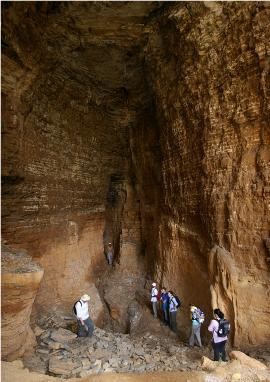India's large mammals have been around for more than 100,000 years, coping with drastic changes in climate and one of the world's largest volcanic eruptions, a new study1 says .
While woolly mammoths, sabre toothed cats and mastodons were disappearing from northern Eurasia and the Americas, mammals continued to thrive in the Indian subcontinent, and in southeast and southwest Asia, the study adds.
An international team of scientists led by Ravi Korisettar from Karnatak University and Michael Petraglia from the University of Oxford has been excavating a series of caves at Billasurgam in the Kurnool district of Andhra Pradesh. These caves contain layers of sediment differentiated from each other by the kind of minerals they contain. Each layer has been dated — from 200,000 years ago till now.
A changing world
From 2.5 million years ago to about 11,000 years ago, the earth was going through cycles of extreme cooling (glaciations) and warming. There was another critical change taking place — modern humans were marching out of Africa, making advanced tools and becoming efficient hunters. What transpired around this time in the Indian subcontinent has been a puzzle.
The researchers inside the stratified Billasurgam caves. Credit: R. Korisettar
The researchers traced a subspecies of Semnopethicus entellus (Hanuman langur) in the uppermost layers, corresponding to less than 50,000 years ago. Interestingly, its teeth are similar to the larger schistaceus subspecies found in the Himalayas rather than the smaller entellus subspecies found in Billasurgam today. It is possible that the range of the northern subspecies could have extended much farther south, during one of the cooling cycles in the Pleistocene era.
One of the most interesting finds was that of a species resembling Theropithecus cf gelada , a kind of rare monkey currently restricted to the highlands of Ethiopia. Extinct species of this genus are found at numerous fossil sites across Africa, northern India, Israel and Europe. How this gelada relative reached southern India is a mystery.
"This was an unexpected find. It is possible that we have a dispersal of this primate from Africa, consistent with evidence that the ostrich also migrated to India," said Michael Petraglia, senior author of the paper. "We are surprised that of all animals, this one perished. Primates are usually so adaptable."
Enduring a changing world
"We believe that the large and varied environments within India meant that although climatic, environmental or human effects may have caused local extinctions within regions, species and genera were able to survive across India, thanks to interconnections across the subcontinent allowing them to move to more favourable habitats," said Patrick Roberts, first author of the paper.
"During that period, geological basins in India were marginally affected and sustained both human and animal life. Apart from the summer and winter monsoons, there were also abundant ground water springs throughout the year. Basin floors had numerous swamps and lakes, and the so-called seasonal rivers were perennial," said Korisettar.
In contrast, large mammal populations collapsed in Northern Eurasia, Australia, Madagascar and the Americas. "These are very different environments", said Roberts. "The development of very large ice sheets across Northern Eurasia and the Americas made interconnected habitats much harder to come by, unlike in India."
Julien Louys, a paleo-ecologist from the University of Queensland, who was not involved with the study, thinks the main result is plausible. "The fact that Asia seems to have been much more heterogeneous in the Pleistocene means a wide variety of refugia would have been present, allowing animals to migrate and survive," he said.
Roberts feels the study has important lessons for conserving India's large mammals today. "Modern studies have shown that having interconnected habitats facilitates the survival of a number of endangered species. Increasing break-up of these interconnections by human buildings or farming in recent years is making it very difficult for these animals to continue to survive," he said.
